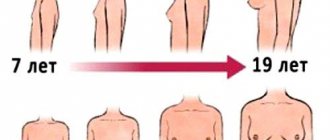Carrying a child, childbirth and breastfeeding seriously affect the process of body change. Young mothers are often afraid of losing the attractiveness of their figure forever. But this fear has no basis - modern plastic surgery offers fast, effective, and most importantly, safe restoration of lost forms.
Mammoplasty after breastfeeding is considered a very successful option. During pregnancy, women, as a rule, give up bad habits and often do not return to them. This way the recovery will be faster. Also, after the end of breastfeeding, the weight stabilizes, which guarantees that the effect of the operation will be consolidated for a sufficiently long period.
Advantages of mammoplasty after breastfeeding
After feeding, various changes in the aesthetics of the mammary glands may be observed:
- areola stretching,
- nipple deformation,
- breast drooping,
- asymmetry and the like.
There is an opinion that giving up breastfeeding will help maintain the beauty of the bust unchanged. This is wrong. Regardless of what decision a young mother makes - to breastfeed or not, changes in the mammary glands begin at the stage of pregnancy, until lactation. There are also cases when nursing mothers’ breast appearance has not changed at all, although these are quite rare, even unique situations.
The intervention of a surgeon allows you to restore the prenatal parameters of the bust and, in most situations, even significantly improve them. Breast augmentation helps solve a number of problems, including those that appeared before pregnancy.
Mastopexy techniques
- Periareolar breast lift . The technique is used for minor prolapse of the mammary glands. An incision is made around the nipple, the breast tissue is carefully redistributed, the nipple is moved to a new position, and the size of the nipple areola is slightly reduced. As an advantage of this method, it can be noted that the scar after the operation is almost invisible.
- Vertical scar lift . The technique is used for significant breast ptosis, in combination with other operations. This method is by far the most popular. A skin incision is made around the nipple and vertically down towards the fold under the breast. In the process of breast lift, the overstretched skin flap is removed, breast contours are formed, and the nipple is moved to a new aesthetic position. The incisions are sutured with a cosmetic suture. After the operation, the scar around the nipple is almost invisible, the vertical scar remains visible.
Types of breast correction after pregnancy
The type and technique of surgery are selected depending on the type and degree of changes that have occurred in the breast. It could be:
- breast lift,
- increase or decrease in volume,
- correction of the nipple-areolar complex,
- correction of deformations, asymmetry, etc.
The operation can be a combination of several types. Often, patients need to combine a breast lift with augmentation or a lift with deformity correction. Reduction of glands is relatively less common.
Breast augmentation can be performed using implants or lipofilling. The optimal type of correction, method of operation, as well as the appropriateness of the intervention are determined by the plastic surgeon at the first consultation.
Questions for the surgeon: breast lift
# planning for out-of-towners
# before pregnancy # before or after childbirth # feeding after surgery # surgery after childbirth, weight loss # how many times can you do it # safety # age # fibroadenoma # contraindications # shape and size # preparation for surgery # piercing # examination # whether to stop taking medications # anesthesia # degree of ptosis and type of lift # implants # without implants # lift or reduction # asymmetry correction # tubularity # areola reduction # nipple correction # rehabilitation # flights # sports # sensitivity # scars # stretch marks # ailments # complications # weight loss, sagging , correction # non-surgical # dissatisfaction with the result # repeat operation # clinic and documents # cost and form of payment # combination of operations
When is the best time to have plastic surgery?
A woman’s desire to get in shape as soon as possible is quite natural and understandable. But there is still no need to rush into this. After the end of lactation and feeding, it is recommended to wait about six months. Six months after the cessation of milk production, as a rule, is enough to stabilize hormonal levels, restore tissue structure and consolidate the final changes (shape, volume).
In addition, by this time, a certain weight will most likely have already been reached, which will also have a beneficial effect on the result. There is no point in planning significant changes to your figure after surgery. Significant weight fluctuations after correction can worsen the expected aesthetics and negate all the surgeon’s efforts.
When vertical mastopexy is contraindicated*
The list of contraindications includes:
- diseases of the endocrine system, including diabetes;
- any chronic diseases in the acute stage;
- blood clotting disorders;
- ARVI;
- neoplasms of malignant or unknown nature;
- the presence of foci of rashes in the chest area caused by dermatological diseases;
- age up to 18 years (the female breast is still actively forming);
- pregnancy;
- lactation and the period for six months after its completion;
- pregnancy planning, etc.
*This information is for informational purposes only. You will receive more detailed information during a consultation with your surgeon.
How does mammoplasty affect subsequent pregnancies and breastfeeding?
The question of whether it is possible to plan the birth of children and breastfeeding after correction worries many patients. There are a number of myths that the operation makes it impossible to feed in the future. This is a very persistent misconception that has nothing to do with reality.
In fact, a properly carried out correction does not in any way affect lactation. Modern surgical techniques are sufficiently low-traumatic and safe to maintain the ability to breastfeed in the future. The type of correction is important: it is worth paying attention that after a T-shaped lift you cannot breastfeed; with other types, breastfeeding remains possible. But subsequent pregnancies, of course, will affect your appearance - for example, the bust may drop again or lose shape. With a high degree of probability, repeated correction will be required. Therefore, it is best to do mammoplasty after breastfeeding the last child, when a new addition to the family is no longer planned. If this is not possible, you should be prepared for a second visit to the surgeon.
How to save breasts
Every pregnant and lactating woman sooner or later thinks about what her breasts will look like after feeding. There is a myth that pregnancy and breastfeeding spoil the shape of the breasts, or more accurately, it changes them. How pronounced these changes will be, and how your breasts will look in a year, depends on you.
There are two standards for beautiful breasts - beautiful girl breasts and beautiful female breasts. A beautiful girl's breast is an elastic cone or hemisphere without a hint of a fold under the breast. Beautiful female breasts have a more rounded shape, a softer consistency and allow for a shallow (up to 2-3cm) fold under the breast. Breast volume may vary, but it should first of all be proportional to the figure of its owner. Some people like big breasts, while others like them small, so that they “fit in the palm of their hand,” but if the breasts sag, it looks unattractive no matter the size. Stretch marks on the skin of the mammary gland also look unattractive.
It is always necessary to take care of the beauty of your breasts, but especially during pregnancy and breastfeeding.
From the first weeks of pregnancy, the breasts increase in volume, preparing for their most important function - milk production. During pregnancy and lactation, almost any woman can boast of a gorgeous bust. But breastfeeding does not last forever and the young mother begins to look around at her friends who previously breastfed and suddenly discovers that some have sagging breasts, while others have managed to maintain the shape of their breasts. In order to understand why the shape of the breast changes, it is necessary to remember the anatomy of the breast.
Schematically, the mammary gland can be represented as a complex of glandular and adipose tissue, enclosed in a sheath of skin and fascia. The basis and support for the mammary glands are the pectoral muscles attached to the ribs. The amount of glandular and adipose tissue determines the volume of the mammary gland, and the elasticity and shape of the breast is determined by the ratio of the volume of the fascial skin “sheath” and the volume of adipose and glandular tissue. During pregnancy, the volume of glandular tissue of the mammary gland increases, as body weight increases, adipose tissue is added, then (during feeding) the volume of milk is added. Additional volumes stretch the “shell”. In the absence of properly selected underwear, gravity is added to this factor, which can lead to ptosis (sagging) of the breasts and the appearance of stretch marks even during pregnancy.
After finishing feeding the baby, the breasts lose these volumes. If the skin-fascial cover of the mammary gland is sufficiently elastic and its stretching was moderate, then its natural contraction occurs and the shape of the breast changes slightly. With a significant change in the volume of the mammary glands, insufficient elasticity of the skin and lack of appropriate care, breast sagging occurs.
You should take care of maintaining breast shape and preventing stretch marks from the first weeks of pregnancy.
The following rules must be observed:
1. Bra requirements:
- should support the chest well, preventing it from sagging, but also not squeezing it
- it is necessary to select a strictly appropriate size at a given time
- do not wear small bras and do not buy “for growth”
- Preference should be given to bras with wide straps located vertically up along the nipple line.
- from the second half of pregnancy until the end of breastfeeding, the bra is worn around the clock; for the night, a wire-free model is selected.
2. Regular use of creams containing nourishing oils will be a good prevention of stretch marks and will maintain the tone of the breast skin.
3. During pregnancy, the breasts do not need massages, dousing with cold water, or rubbing the nipples. Massage and rubbing of the nipples are dangerous, especially in the second half of pregnancy, as they can provoke miscarriage.
4. Don't worry if you have flat or even inverted nipples. By teaching your baby to properly latch on to the breast during feeding, there will be no problems with sucking.
5. Exercises to strengthen the chest muscles during this period are contraindicated; the additional volume of pumped up pectoral muscles will only further stretch the fasciocutaneous membrane of the mammary gland.
6. Do not gain excess weight; excess adipose tissue will further stretch the fasciocutaneous cover of the mammary gland.
Rules to follow while breastfeeding:
1. After childbirth, the bra is changed to a special one for breastfeeding and worn around the clock. Its size should also exactly match the size of your breasts. For sports, use a bra that will limit breast mobility as much as possible.
2. Give preference to natural feeding at the request of the child.
3. Do not limit feeding time or number of feedings. If a child eats longer or more often than other children, it means he needs it.
4. Avoid stagnation of milk by maintaining approximately the same amount of milk on each side. To do this, you need to attach the baby alternately - first to one breast, then to the other.
5. Make sure your baby is latching on correctly during feeding. The correct grip looks like this: the child’s mouth is wide open, the lips are turned out, the chin is pressed to the chest, the entire nipple circle is in the child’s mouth (or most of it, if the areola is very large).
Support your baby's head and back so that he is comfortable and does not "hang" on your chest during feeding.
6. Avoid long breaks between feedings.
7. If the child does not eat at night, empty both breasts before bed so that the overfilled breast does not stretch, or watch the child during sleep - at the moment when the child begins to worry, sucking his fist or smacking his lips in his sleep, you can offer him the breast.
8. It is preferable to use a breast pump for expressing. When manually expressing, try not to stretch the breast tissue.
9. Do not offer your child supplementary feeding, complementary foods, water, dill water, tea or expressed milk and a pacifier, unless the pediatrician insists on it.
10. If you experience pain or lumps in the breast, seek medical help as soon as possible. You will be helped at the breastfeeding support center while conservative treatment is possible, and our mammologist Magomedova Imanat Zainulubidovna if more serious measures are necessary.
After cessation of breastfeeding, as late and gradually as possible, a reduction of glandular tissue occurs in the mammary gland and its partial replacement with adipose tissue. If the elasticity of the fasciocutaneous membrane and Cooper's ligaments is preserved, the mammary gland almost does not change its shape.
If the shape of the breast has changed, it can be improved by affecting the skin of the breast or increasing the volume. The tone of the breast skin can be increased with the help of mesotherapy, plasma lifting and other cosmetic measures.
Another direction for improving breast shape is physical exercise, myostimulation of the pectoral muscles. Increasing the volume of the chest muscles will slightly compensate for the lack of volume of the mammary gland relative to the stretched fasciocutaneous pocket and will improve the shape of the breast. Strengthening the pectoral muscles should be started closer to the end of breastfeeding, otherwise the additional volume of the pectoral muscles will stretch the skin of the mammary gland. But no amount of exercise can tighten the skin or the breast tissue itself.
If, after finishing feeding, your breasts look just like a “deflated balloon,” exercises and cosmetology will be ineffective. It will be possible to restore the shape of the breast only with breast surgery.
Various methods of breast plastic surgery restore shape and firmness; if necessary, breast volume is reduced or increased. Most often, breast plastic surgery involves reducing the fasciocutaneous cover of the mammary gland and can be supplemented by enlarging the mammary gland using implants. At a preoperative consultation with a plastic surgeon, the woman’s desire to breastfeed in the future must be clarified, since some types of plastic surgery allow breastfeeding, while others make it impossible. If you want to breastfeed later, it is better to give preference to the installation of implants and the least traumatic methods of breast lift. Simultaneous installation of implants and breast lift is possible. There is no need to worry that the silicone of the implants will somehow get into breast milk. Certified implants have a multi-layer shell and do not allow even traces of silicone to escape beyond its boundaries. The shell of modern implants can withstand pressure of up to 300(!) kg per 1 sq. cm. Implants have virtually no effect on breast tissue.
For those who are categorically against silicone, Arion currently produces hydrogel implants. If the hydrogel leaves the shell (due to injury), it turns into harmless carbon dioxide and water.
If there are stretch marks on the skin of the breast, the operation can be supplemented with laser breast resurfacing. Laser resurfacing will make not only stretch marks invisible, but also scars.
Getting beautiful breasts is possible at any age if you approach the matter professionally. I hope this page will help preserve (or restore) the beauty of your breasts. If you don’t know how to get your breasts in order, or, despite all your efforts, they are far from ideal - contact us! Perhaps the solution to your problem is easier than you think.
With respect, plastic surgeon, head of the plastic surgery department of the Health Factory MC Zelenkova Natalya Vyacheslavovna
Recovery process after surgery
Currently, surgical techniques require a very rapid rehabilitation process. Still, you will have to give up some things for a while. It is necessary to wear special compression garments throughout the recovery period.
You will also need to give up active sports, avoid heavy physical activity (especially weight lifting), sleeping on your stomach, solariums and beaches. Of course, these restrictions only apply during the postoperative period. When the tissues heal and the bust takes its final shape, it will be possible to return to the same lifestyle as before the operation, with the exception of active work of the shoulder girdle (for example, bench press). It takes about 6-9 months for scar tissue to form.
Indications for the procedure:
- loss of breast shape and volume after lactation;
- age-related changes;
- asymmetry;
- breast ptosis due to significant weight loss;
- breast correction after surgery and trauma;
- Poland syndrome - underdevelopment of the musculoskeletal system of half the chest, which leads to asymmetry;
- congenital or acquired defects of areolas and nipples.
Breast correction is performed not only for women, but also for men. The indication for the procedure in men is gynecomastia – a noticeable enlargement of the mammary glands.
How to prevent loss of shape?
To protect your breasts as much as possible from possible changes, you can follow some rules when feeding your baby. It is better to place the baby alternately on different breasts to prevent asymmetry. If you need to express milk, it is recommended to use breast pumps. It is undesirable to allow serious fluctuations in weight, otherwise the formation of “voids” and ptosis cannot be avoided.
A contrast shower and a light massage will not be amiss. For one minute, a shower stream is directed to each breast in turn. Each approach the temperature should change slightly. The massage is carried out with soft circular movements, without strong pressure.
If the measures taken turned out to be powerless, there is no need to be upset. Mammoplasty after breastfeeding will help eliminate any defects and make the bust aesthetically perfect. The main thing is to impeccably follow all the recommendations of your doctor, and the result will not be long in coming.
Preparing for surgery
To undergo breast lift surgery, it is necessary that at least 12 months have passed since the date of birth. It is important that a woman does not plan to have another child in the coming years. Otherwise, the next time you breastfeed, there is a high risk that the breasts will still sag, even if plastic surgery has been performed.
Mastopexy is always performed under general anesthesia. Therefore, before surgery, a woman needs to be examined and pass all the required tests. This is blood, urine, testing for syphilis and HIV, viral hepatitis B and C, ECG, coagulogram, ultrasound of the mammary glands, fluorography. If the result reveals any abnormalities, the doctor will postpone the operation or cancel it altogether.
Doctors' recommendations before surgery are to completely stop drinking alcohol and smoking 14 days before surgery and 14 days after it. This will prevent the development of possible complications after plastic surgery.
On the day of surgery, you should not eat anything if the operation is scheduled for the first half of the day. If the operation is planned in the afternoon, a light operation in the morning is possible in consultation with the doctor.
Call a breastfeeding specialist to your home
At the Group’s children’s medical centers, we know that the most convenient place for breastfeeding consultations is your own cozy home:
- A specialist will come to you at a convenient time. You don't have to go to the clinic and wait in line. Consultations can also be held directly in the maternity hospital (if visits are permissible) or in a medical center.
- A familiar home environment makes consultation easier for both mother and child.
- At home, the consultant will be able to devote more time to both the child and the parents.
- The consultant is always a phone call away: day and night (at night you can call the contact center or write to the consultant, the consultant will answer as soon as possible), on weekdays and on weekends.
- Support from a specialist is not one-time consultations, but accompaniment: the consultant will visit the mother and baby again, if necessary, after 2-4 weeks to check how feeding is going and the baby’s weight gain.
In addition to calling a breastfeeding specialist to your home, you can call doctors of the main specialties: pediatrician, surgeon, allergist, urologist, pulmonologist, hematologist, dermatologist, ophthalmologist, ENT doctor, orthopedist, gastroenterologist and osteopath. You can also take tests, perform physiotherapy and massage at home. Infant swimming consultants can advise you at home and conduct a master class.
Find out about the special offer “Comprehensive examination at home”: the convenience of this program is that you can choose from a list of pediatric doctors exactly those specialists that your child needs and an individual set of medical services with a 20% discount!
Stages of the procedure
- In order for the operation to be successful, at least two weeks before the operation, completely give up alcohol, smoking, taking hormonal drugs, aspirin and other drugs that affect blood clotting.
- The day before, do not eat heavy, rich food and try to have dinner no later than 18.00. On the day of the procedure you should not eat or drink.
- Breast surgery is performed under general anesthesia and takes on average about two hours.
- If there are no complications and you feel well, after 24 hours (or 48 hours if indicated), you can leave the clinic and return home.
Birth of a child
Looking good is not just the motto of the fair half of humanity, it is one of the necessary parts of life. For every woman, not only beautiful clothes are important, but also an impeccable figure. That is why beautiful ladies always try to take care of the beauty of their bodies.
However, there is another important part in life - the birth of a child. It is hardly possible to meet a woman who would give up maternal happiness in exchange for a slender figure. Yes, this is not necessary! Indeed, today our medicine has made a profound breakthrough in the field of plastic surgery. Therefore, regaining your beautiful figure will not be difficult. This is especially true for the mammary glands, which in 80% of cases lose their shape after childbirth and breastfeeding. And if losing excess weight and tightening your abs is possible with the help of sports exercises, then only an experienced plastic surgeon can help restore your breasts.
Recovery period:
For the day after surgery, it is better for the patient to be under the supervision of doctors in the clinic. Immediately after the intervention, she will be put on a compression top bra, which will need to be worn for a month, only being removed for showering after all the incisions have healed. Behavior during the rehabilitation period depends on the volume and technique of the operation and the presence of an implant. Usually in the first 7-10 days you need to come for an examination, dressings and final removal of stitches. For a month to a month and a half, you should avoid intense physical activity on the upper body, do not go to the sauna, and try to sleep on your back so as not to put strain on the suture and increase swelling. After the simplest periareolar lift, you can return to normal life after two weeks. An anchor lift will require a longer recovery - it can take 3 to 6 months for the discomfort to completely disappear. And most importantly, after any type of lift, surgeons recommend monitoring your weight and avoiding sudden fluctuations.
Physiological changes: why breasts become smaller after childbirth
After the birth of a baby, the level of prolactin and oxytocin rapidly increases in the female body. The functioning of the mammary glands depends on these hormones. As a result of their release into the body, the breasts enlarge and begin to produce milk. Moreover, if the gland has become large, this does not mean at all that there will be a lot of milk.
See also: Retrocervical endometriosis: diagnosis and treatment
Upon completion of feeding, the hormonal levels stabilize, and the glands stop producing milk and are reduced in volume. It is during this period that it becomes noticeable how much the breasts have shrunk. Meanwhile, with the “correct” return of the body to its natural state, the lack of glandular tissue is compensated by the formation of fatty tissue. This does not happen immediately, so many women, trying to speed up the completion of lactation, can themselves provoke a loss of bust size.








